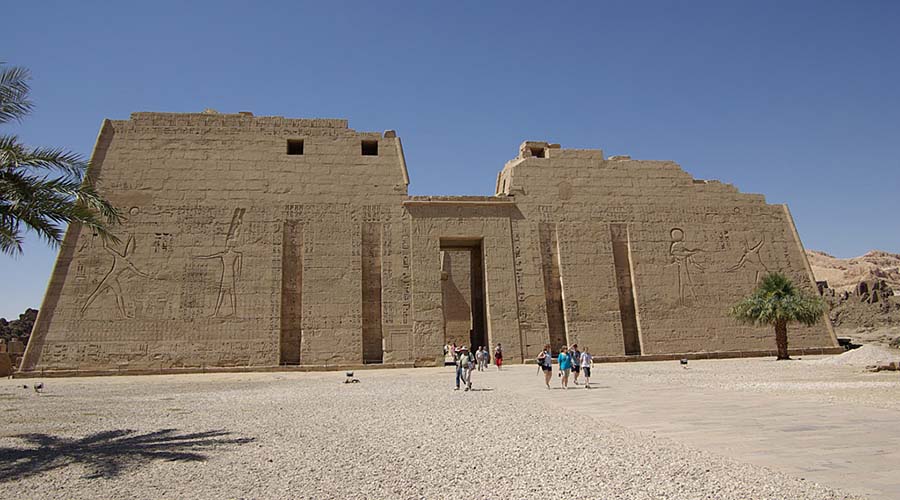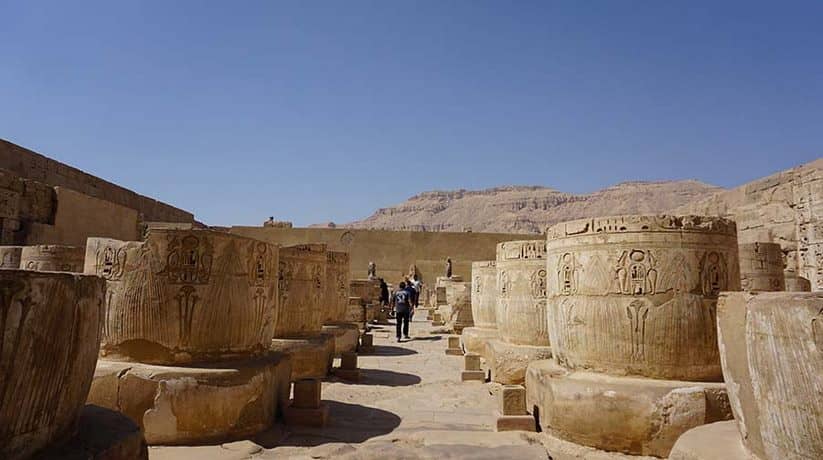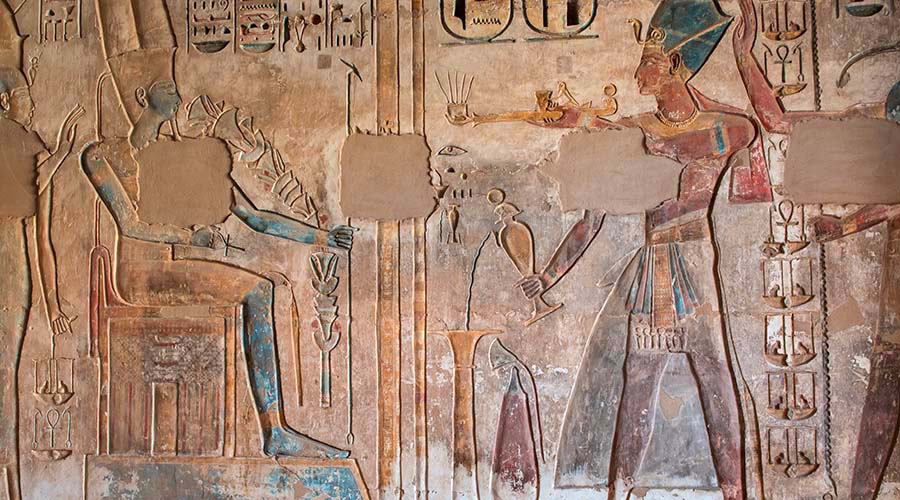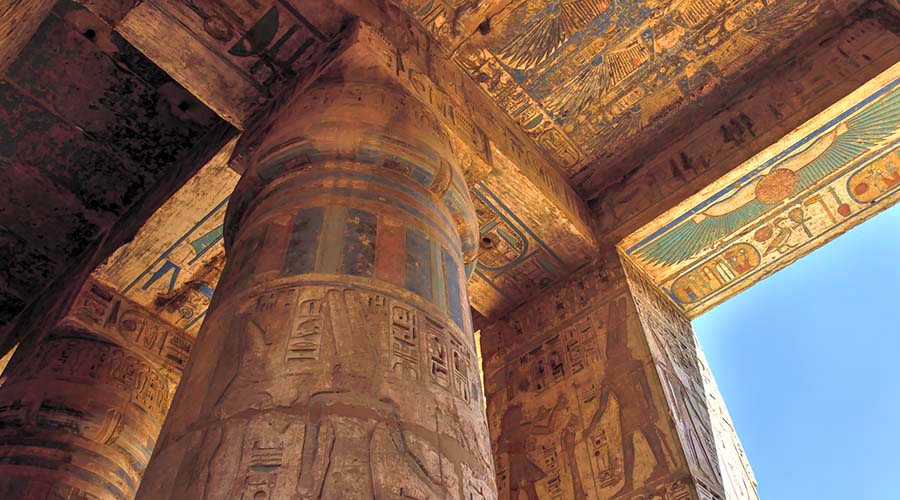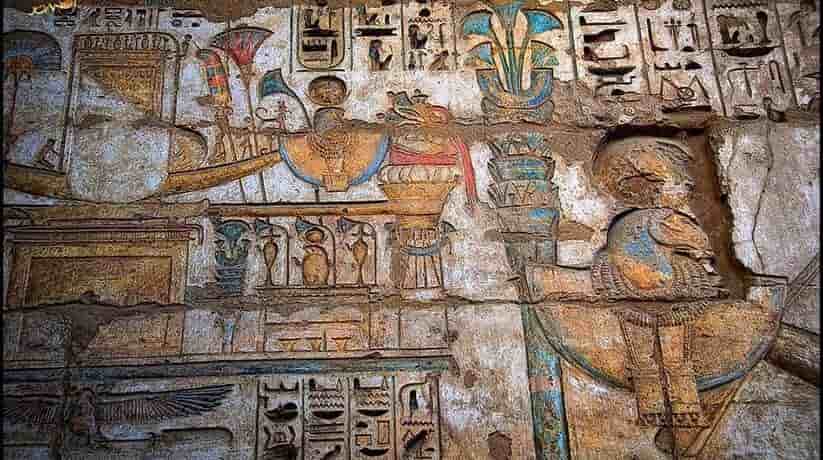Medinet Habu Luxor Egypt tours, prices, booking, reviews
Medinet Habu Luxor Egypt (City of Habu) located in the west bank in Luxor. The ancient Egyptian name of Medinet Habu was Djamet. It means meaning males and mothers. Its holy ground believed to be where the Ogdoad, the four pairs of first primeval gods buried. In fact, the site was both a temple and a complex of temples. It dates back to the New Kingdom. It adjoins the cultivation at the southern end of the Theban necropolis. The area was one of the earliest places within the Theban region to associated with the worship of Amun. The Hatshepsut and Thutmose III built a small temple to Amun on the site of an earlier structure. Next to their temple, Ramses III built his mortuary temple. It is Medinet Habu Luxor’s most conspicuous standing monument.
Ramses III then enclosed both structures within a massive mud-brick enclosure. It included storehouses, workshops and administrative offices. It also included residences of priests and officials. On the grounds of the entire temple complex are many other structures. It is besides the small temple. There are the memorial chapels of the Divine Adoratrices of Amun. Less well preserved is the memorial temple of King Horemheb. He usurped it from his predecessor Ay. The temple stands on the north side of the Ramses III enclosure. To its east are many of tomb chapels made for high officials of the later new Kingdom.
Further details about Medinet Habu Luxor Egypt:
The main temple at Medinet Habu Luxor is the great memorial temple of Ramses III. In fact, it indeed the best preserved of all mortuary temples of Thebes. Moreover, it called the Mansion of Millions of Years of User-Maat-Re Meriamun. It is the throne name of Ramses III. In fact, it contains more than 75,350 sq ft of decorated surfaces across its walls. The temple precinct measures about 700 feet by 1000 feet. It entered by two stone gates in the mud brick enclosure wall. It is on both the eastern and western sides. The western gate destroyed when the temple besieged during conflict in the reign of Ramses XI. The eastern entrance fronted by a quay, at which the boats that came in via the canals could moor.
The processional way led first between two porters lodges. They set into a low stone rampart. Moreover, they built in front of the main enclosure wall and then into the precinct. The rampart itself was a large gateway of distinctive design. It modeled after a western Asiatic migdol or fortress. The gateway side fronted by guard houses. They decorated with images of the king trampling enemies of Egypt and sculpted figures of the monarch. Moreover, they stand atop the heads of captives project from the walls. A large relief representation of the god Ptah was here. It had the power to send the prayers of those unable to enter the temple. They enter to the great god Amun. The upper rooms of the gate-house functioned as a kind of royal retreat or harem. Their walls graced with representations of the king relaxing with young women.
More details about Medinet Habu Luxor Egypt:
Perhaps it was here that the attempted assassination of Ramses III took place. The temple itself is a smaller copy of the Ramesseum which built by Ramses II. Its massive outer pylons are the most imposing of any temple in Egypt. They decorated with colossal images of the king destroying captured enemies before the gods. The temples outer walls also depict important battle and victory scenes. They are over the Libyans and Sea Peoples. These scenes continued into the first court. On the northern side of Medinet Habu court were large statues of king Osiris. On the south, there is a columned portico with the window of appearances. It is in which the king stood or sat during formal ceremonies and festivities. The large statues of the second court of the site destroyed. It was in the early Christian era when the area converted into a church.
Relief scenes in Medinet Habu Luxor still in good condition. They depict rituals connected with the god Min. On the rear wall of the portico, a procession of the kings many sons and daughters. The second court of the site, devoted to scenes of religious processions. They belong to Min and Sokar. The Hypo-style hall suffered too much. The columns reduced to a small fraction of their original height. In the southwest corner of the site is a treasury building. It is with scenes depicting some of the temple equipment. The weighing of gold, depictions of sacks of gold, and precious stones also appear on the walls. Other temple valuables kept in a better concealed building. It is immediately in front of the north wall of the sanctuary.
Further details about Medinet Habu Luxor Egypt:
Off to the left of the second Hypo-style hall is the funerary chamber of Ramses III. It is with the god Thoth who shown inscribing the kings name on the sacred tree of Heliopolis. The focus of the main axis of the temple is the sanctuary of Amun. It was once finished in elect-rum with a doorway of gold. The doors themselves of copper inlaid with precious stones. Behind the sanctuary lies a false door for Amun-Ra united with eternity. It is the divine form of Ramses III. On the southeastern side of the temple are the remains of a royal palace. It was much smaller than the kings main house. In fact, it served as a spiritual palace as well as the occasional royal visits. Moreover, it decorated with glazed tiles. Its bathrooms lined with limestone to protect the mud-brick.
From the palace, the king could enter the first court. He also could peruse it from a window of appearances on its southern side. To the right of the complex entrance of Medinet Habu Luxor stands the earliest section of the complex. It called The Small Temple. Moreover, it founded in the 18th Dynasty and expanded and usurped under later dynasties. It stood on one of the most sacred spots in all Egypt. It is the primeval hill which first rose out of the receding waters of Chaos. An inscription describes it as the burial place of the four primal pairs of gods. The core of this temple begun by Hatshepsut and Thutmose III. But her name later replaced by those of Thutmose I and II. The structure incorporated into Ramses temple complex. It eclipsed by the construction of the mortuary temple.
More details about Medinet Habu Luxor Egypt:
Its entrance later replaced by a pylon of the Nubian King Shabaka. And then, it usurped by his nephew Taharqa. A small fronting gateway built during the 26th Dynasty at Medinet Habu. To the north of this Small Temple are the sacred lake. It called Nilometer. It is actually a well with a passage leading down to groundwater level. Inside and to the left of the eastern gateway of the site are a group of chapel-tombs. They belonging to the 25th and 26th Dynasties Gods Wives of Amun. They ruled Upper Egypt at that time.
On the lintels above the entrances to these chapels may still seen the “Appeal to the Living”. It encouraged passers-by to repeat the Offering Formula. It was for the Kas of these powerful women. Because of its strong fortifications, Medinet Habu Luxor became a refuge in chaotic times. The workmen of Deir El Medina moved there during the late 20th Dynasty. The remains of the house of one Butehamun, a village scribe, can still seen there at the western end. During the Christian era, the entire area covered by the Coptic town of Djeme. Even the great temple itself filled with dwellings and one court used as a church.

